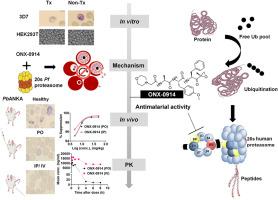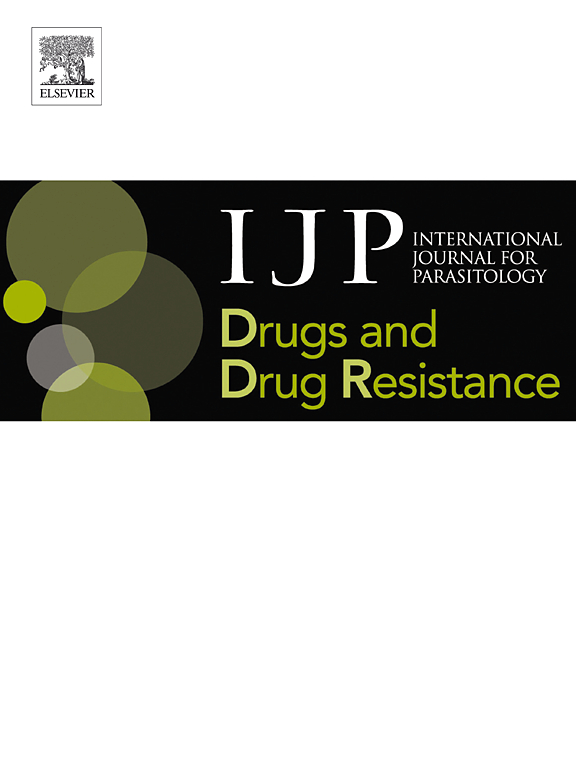Dual-targeting proteasome inhibitor ONX-0914 demonstrates potent antiplasmodial activity for malaria treatment
IF 3.4
2区 医学
Q1 PARASITOLOGY
International Journal for Parasitology: Drugs and Drug Resistance
Pub Date : 2025-09-16
DOI:10.1016/j.ijpddr.2025.100613
引用次数: 0
Abstract
There is an urgent need to discover novel antimalarial drugs that are safe and provide effective cures with broad therapeutic potential, novel mechanisms of action, and suitable pharmacokinetic profiles. We studied ONX-0914, which targets the proteolytic system of eukaryotic cells and has been effective against cancer and immune disorders. The antiplasmodial activity and safety of ONX-0914 were investigated both in vitro and in vivo, along with its mechanism of action and potential bioavailability. Notably, ONX-0914 strongly inhibited the proliferation of various Plasmodium falciparum strains, including chloroquine (CQ)- and artesunate (ART)-sensitive and -resistant strains, with a low nanomolar IC50 (<50nM). It also exhibited potent synergistic activity with ART, blocking the proliferation of ART- and CQ-resistant strains, while showing low toxicity to human cells (CC50 > 100 μM). The potent antiplasmodial activity of ONX-0914 is attributed to the dual inhibition of haemoglobin metabolism and the ubiquitin‒proteasome system. In vivo results revealed that ONX-0914 suppressed P. berghei ANKA parasites by > 95 % after 4 days of treatment and increased survival rate and mean survival time following a single dose administered via various routes (effect dose ED50 of 7.62 mg/kg per oral [PO] and 6.52 mg/kg intraperitoneal [IP], and intravenous [IV]). ONX-0914 treatment resulted in a low recrudescence rate after one month (<2 %), reduced organ lesions (brain, heart, lung, liver, spleen, and kidney) compared to untreated controls, and favourable pharmacokinetic parameters (AUC >20,960 h∗μg/ml, T1/2 = 7.9 h [IV], 0.7 h [PO], C max = 10708.2 μg/ml [PO], bioavailability = 23.83 %), supporting its antimalarial efficacy. Owing to its low toxicity, robust antiplasmodial activity through a combination mechanism, and supportive pharmacokinetic properties, ONX-0914 is a promising antimalarial agent.

双靶向蛋白酶体抑制剂ONX-0914在疟疾治疗中显示出有效的抗疟原虫活性
迫切需要发现安全、有效、具有广泛治疗潜力、新的作用机制和合适的药代动力学特征的新型抗疟药物。我们研究了ONX-0914,它靶向真核细胞的蛋白水解系统,对癌症和免疫疾病有效。对ONX-0914的体内体外抗疟原虫活性、安全性、作用机制和潜在生物利用度进行了研究。值得注意的是,ONX-0914强烈抑制多种恶性疟原虫菌株的增殖,包括氯喹(CQ)和青蒿琥酯(ART)敏感和耐药菌株,具有低纳摩尔IC50 (<50nM)。它还显示出与ART的有效协同活性,阻断ART和cq抗性菌株的增殖,同时对人体细胞具有低毒性(CC50 > 100 μM)。ONX-0914有效的抗疟原虫活性归因于对血红蛋白代谢和泛素-蛋白酶体系统的双重抑制。体内实验结果显示,ONX-0914在治疗4天后对伯氏弓形虫ANKA寄生虫的抑制率为95%,并且通过多种途径单次给药(有效剂量ED50为7.62 mg/kg /口服[PO], 6.52 mg/kg腹腔注射[IP]和静脉注射[IV])后,生存率和平均生存时间均有所增加。ONX-0914治疗1个月后复发率低(2%),与未治疗对照组相比,器官病变(脑、心、肺、肝、脾和肾)减少,药代动力学参数良好(AUC >20,960 h∗μg/ml, T1/2 = 7.9 h [IV], 0.7 h [PO], cmax = 10708.2 μg/ml [PO],生物利用度= 23.83%),支持其抗疟疗效。ONX-0914由于其低毒性、通过联合机制具有强大的抗疟原虫活性以及支持的药代动力学特性,是一种很有前途的抗疟药。
本文章由计算机程序翻译,如有差异,请以英文原文为准。
求助全文
约1分钟内获得全文
求助全文
来源期刊

International Journal for Parasitology: Drugs and Drug Resistance
PARASITOLOGY-PHARMACOLOGY & PHARMACY
CiteScore
7.90
自引率
7.50%
发文量
31
审稿时长
48 days
期刊介绍:
The International Journal for Parasitology – Drugs and Drug Resistance is one of a series of specialist, open access journals launched by the International Journal for Parasitology. It publishes the results of original research in the area of anti-parasite drug identification, development and evaluation, and parasite drug resistance. The journal also covers research into natural products as anti-parasitic agents, and bioactive parasite products. Studies can be aimed at unicellular or multicellular parasites of human or veterinary importance.
 求助内容:
求助内容: 应助结果提醒方式:
应助结果提醒方式:


